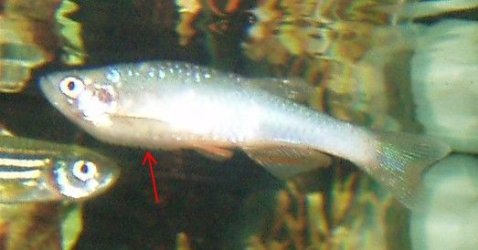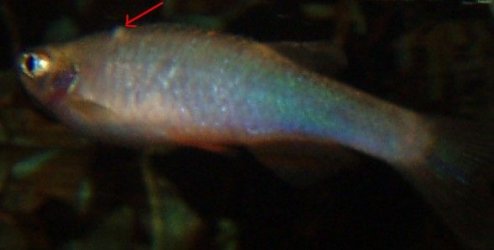Not the writer of this information below.
Dropsy
Symptoms:
This disease is very common among African Cichlids, and is commonly called "Malawi Bloat," even though it affects fish from Lakes Tanganyika and Victoria. Dropsy is also very common within the Carp family and among Anabantids. It is characterized by swelling of the body and especially abdomen, which causes the scales to stand out with a pine cone appearance. Eyes may protrude or cave in. Reddening at the vent and/or base of fins may be observable as well as body ulcers and long pale feces. In advanced cases, skin discoloration and scale loss may also occur. Sick fish will not show any desire for food. They will often hang near the bottom, resting on the gravel, or at the top, gasping for air. In the latter stages of this disease, the fish may lose its equilibrium and hence ability to swim properly.
Cause:
Three main causes for Dropsy have been identified. The over use of salt (NaCl), prolonged exposure to poor water conditions, and improper diet, which lead to a parasitic infection. Other causes include poisoning, internal injuries and cancerous tumors. The swelling is not the disease itself, but rather a symptom, which is caused by a build-up of fluids in the body cavity due to internal organ failure.
Treatment:
Treatment of this disease is difficult, as by the time it is recognized, permanent damage to the internal organs of the fish will have occurred. Immediate treatment must be performed if there is to be any chance for survival. Metronidazole (Flagyl) and or Clout are the best medications for treatment of Dropsy. Notwithstanding, not much is known for certain about the etiology of this disease and some experienced aquarists use antibiotics to fight Dropsy. For oxytetracycline, baths of 20-100 mg/litre for five days is suggested. For tetracycline hydrochloride, treat with baths of 40-100 mg/litre for five days. And for minocycline hydrochloride a dilution of 250mg/10 gallons of water is recommended. On day 2 change all the water and add the medicine again at the same dose for another 2 days. Increase aeration during treatment. Do not use minocycline a third time in a row. Caution: tetracyclines are photo sensitive so turn the tank lights off during treatment and cover the whole tank with a blanket. If the fish is still eating, you can soak the food in a concentrated solution of the antibiotic before feeding.
You can read more about this disease, treatment, and how to prevent it in the future by reading our article: Malawi Bloat.






